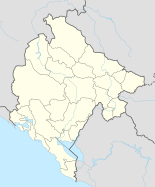Budva
|
Budva Будва |
||||
|
||||
| Basic data | ||||
|---|---|---|---|---|
| State : |
|
|||
| Municipality : | Budva | |||
| Coordinates : | 42 ° 17 ' N , 18 ° 51' E | |||
| Height : | 3 m. i. J. | |||
| Residents : | 13,338 (2011) | |||
| Telephone code : | (+382) 033 | |||
| Postal code : | 85310 | |||
| License plate : | BD | |||
Budva ( Cyrillic Будва , Italian Budua ) is a city in the municipality of the same name in Montenegro with about 13,000 inhabitants. The place was originally on an island, which is now connected to the mainland by a sandbank. It is one of the oldest places on the Adriatic , founded over 2500 years ago by Kadmos , the son of the Greek - Phoenician king Agenor , according to ancient mythology . The city was almost completely destroyed in an earthquake in 1979, but it was rebuilt true to the original. Today Budva is primarily a seaside resort.
history
The city was first established in the 4th century BC. Mentioned as an Illyrian settlement before that, since the 10th century BC. A Greek colony and came in the 2nd century BC. Under Roman rule.
In 1186 the city was annexed to his kingdom by the Serbian King Stefan Nemanja , from 1442 it belonged to the Republic of Venice . In the 16th century the city was attacked and sacked by the Ottomans . After the fall of Venice, Budva became Austrian and stayed that way until the First World War . Only in 1813 was the city under Montenegrin rule for one year. The Roman Catholic diocese, which had been orphaned for a long time, was abolished in 1828.
From 1918 to 2003 Budva was part of Yugoslavia . During the Second World War , Germans and Italians occupied the city. During this time it formed a center of the Yugoslav partisan movement , which it liberated in 1944.
population
At the 2011 census, the city of Budva had 13,338 inhabitants, of whom 6847 (51.33%) identified themselves as Montenegrins and 4779 (35.83%) as Serbs . In addition, other smaller population groups live in the city, the most important of them being Russians and Croats .
Attractions

The old town is surrounded by a medieval city wall and is a listed building. Most of the buildings in the old town were damaged or completely destroyed by the earthquake on April 15, 1979 and reconstructed stone by stone in the Venetian style according to plans from Austrian archives.
Two of the most important structures in Budva are the three-aisled Church of St. John the Baptist from the 9th century and the Orthodox Church of the Holy Trinity from 1806. Another Orthodox church is on the site of the Podmaine Monastery, which is on the outskirts.
To the west of the city, at the foot of the Spas mountain, is the Mogren fortress, built by Austrians in 1860. Kosmač fortress, also built by Austria-Hungary in the 1840s, is located on the road from Budva to Cetinje . It was the southernmost fortress of the Habsburg Empire . There are also some monasteries of cultural and historical importance.
Budva Bay is also bounded by the small island of Sveti Nikola (also known as Havaj among the population , derived from Hawaii). It is the largest island in Montenegro and used to be accessible on foot over a headland. Today it is uninhabited except for the lighthouse keeper, but can be reached by boat in summer.
Budva Bay and Sveti Nikola Island ("Havai")
Twin cities
- Novi Sad , Serbia
- Velika Plana , Serbia
literature
- Danilo Kalezić (Ed.): Budva . Beograd 1996, ISBN 86-429-0107-1 ( travel and art guide for Budva and the surrounding area )
- Žika Bujuklić: Pravno uređenje srednjovekovne budvanske komune . Budva 1988, ISBN 86-427-0027-0
- Statuta et leges civitatis Buduae, civitatis Scardonae et civitatis et insulae Lesinae . Opera Simeonis Ljubic. (= Monumenta historico-iuridica Slavorum meridionalium. Volume 1,3). Zagrabiae 1882-1883.
Web links
Individual evidence
- ↑ Ethnic composition of Montenegro 2011. In: pop-stat.mashke.org. Retrieved October 11, 2018 .






